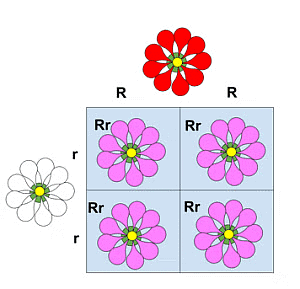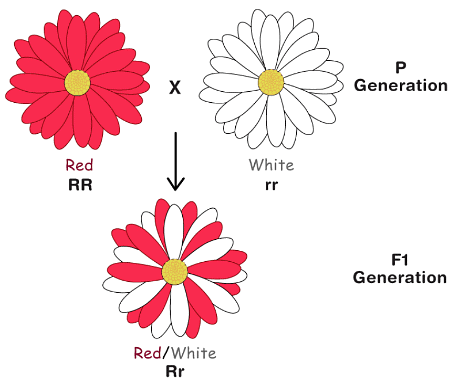Inheritance of One Gene | Biology for JAMB PDF Download
Incomplete Dominance
“Incomplete dominance is a form of intermediate inheritance in which one allele for a particular trait is not completely over its paired allele.”
Incomplete dominance is a form of Gene interaction in which both alleles of a gene at a locus are partially expressed, often resulting in an intermediate or different phenotype. It is also known as partial dominance.
For eg., in roses, the allele for red colour is dominant over the allele for white colour. But, the heterozygous flowers with both the alleles are pink in colour.
Mechanism of Incomplete Dominance
Incomplete dominance occurs because neither of the two alleles is completely dominant over the other. This results in a phenotype that is a combination of both.
Gregor Mendel conducted experiments on pea plants.
He studied on seven characters with contrasting traits and all of them showed a similar pattern of inheritance. Based on this, he generalized the law of inheritance.
Later, researchers repeated Mendel’s experiment on other plants. Shockingly, they noted that the F1 Generation showed variation from the usual pattern of inheritance. The monohybrid cross resulted in F1 Progeny which didn’t show any resemblance to either of the parents, but an intermediate progeny.
Let’s understand the incomplete dominance with the example of Snapdragon flower (Antirrhinum sp.):
Snapdragon Flower
Monohybrid cross was done between the red and white coloured flowers of Snapdragon plant.
Consider, pure breed of the red flower has RR pair of alleles and that for the white flower is rr.
Firstly, true-breeding red (RR) and white (rr) coloured flowers of snapdragon were crossed.
The F1 generation produced a pink coloured flower with Rr pair of alleles.
Then the F1 progeny was self-pollinated.
This resulted in red (RR), pink (Rr) and white (rr) flowers in the ratio of 1:2:1.
Recollect that the genotype ratio of F2 generation in the monohybrid cross by Mendel also gave the same ratio of 1:2:1.

However, the phenotype ratio has changed from 3:1 to 1:2:1.
The reason for this variation is the incomplete dominance of the allele R over the allele r.
This led to the blending of colour in flowers.
Concept of Dominance
In genetics, Dominance is a relationship between alleles of one gene. In order to understand the concept of the dominance of alleles, we need to know more about genes.
So far we know that genes are a hereditary unit in organisms which exist as a pair of alleles in diploid organisms. These pair of alleles may or may not be similar. That is, a heterozygous gene has two dissimilar pairs of alleles while homozygous have identical ones.
Heterozygous alleles carry different information on traits. When we say one trait is dominant over the other, there can be two reasons:
- either it is non-functional, or
- is less active than the normal allele
Codominance
"Co-dominance is the type of dominance where the offspring show similarity to both the parents and it is due to the blending of alleles. "
Incomplete dominance and codominance are different from each other.
In codominance, both the alleles present on a gene are expressed in the phenotype.
A flower showing codominance will have patches of red and white instead of a uniformly pink flower.
 Flower with Codominance
Flower with Codominance
The humans with AB blood type also show codominance where the alleles for both blood types A and B are expressed.
Co-Dominance and Multiple Alleles
ABO Blood Grouping
There are different types of red blood cells such as A, B, AB and O with or without the Rh factor. The difference is in the antigen present on the red blood cell surface which determines the specific blood group in an organism.For example: If a person is blood group A, it means the RBC surface consists of antigen-A. But this is decided by the gene I. The gene I have three types of alleles namely, IA, IB and i. The alleles IA and IB produce two different antigens while the allele-i do not produce any antigen. Hence, alleles IA and IB are dominant over the allele i.
As we know, each diploid organism bears two pairs of alleles. Hence, in humans, there are two types of alleles of any combination. Depending on the combination and dominance of allele blood type of an individual could be determined. The different combination of alleles and their type of blood groups are given below:

In the above example:
A person with blood group A indicates that he has an IA and i pair of alleles. This is because the allele i is recessive in character and no antigen is produced. However, a person who possess both the alleles IA and IB, they have blood group AB. This is because of alleles IA and IB are codominant. Both the gene will produce their type of antigen.
|
225 videos|175 docs|156 tests
|
FAQs on Inheritance of One Gene - Biology for JAMB
| 1. What is incomplete dominance? |  |
| 2. What is codominance? |  |
| 3. How is co-dominance different from incomplete dominance? |  |
| 4. Can a gene have multiple alleles? |  |
| 5. How are traits inherited in the case of multiple alleles? |  |

















